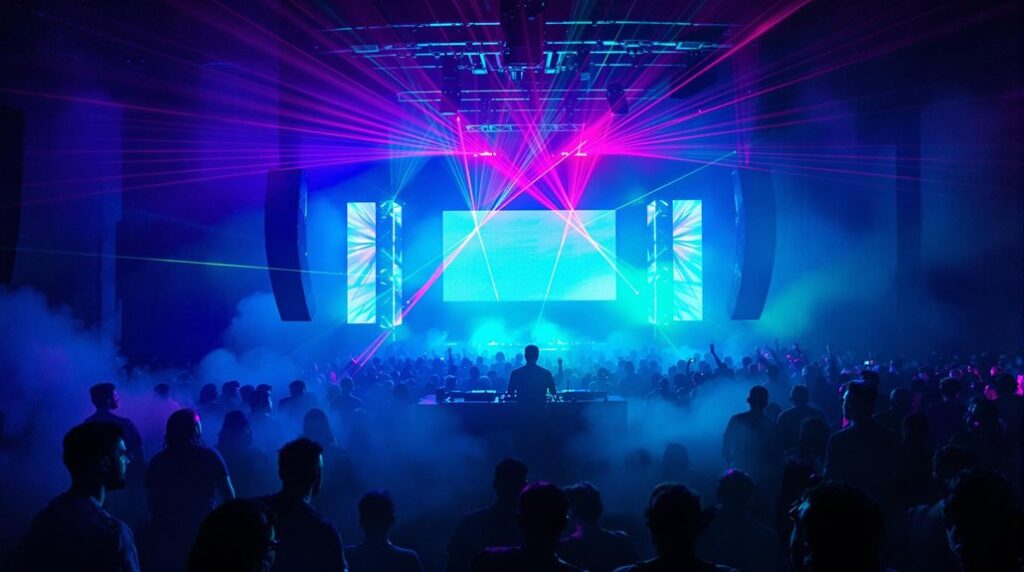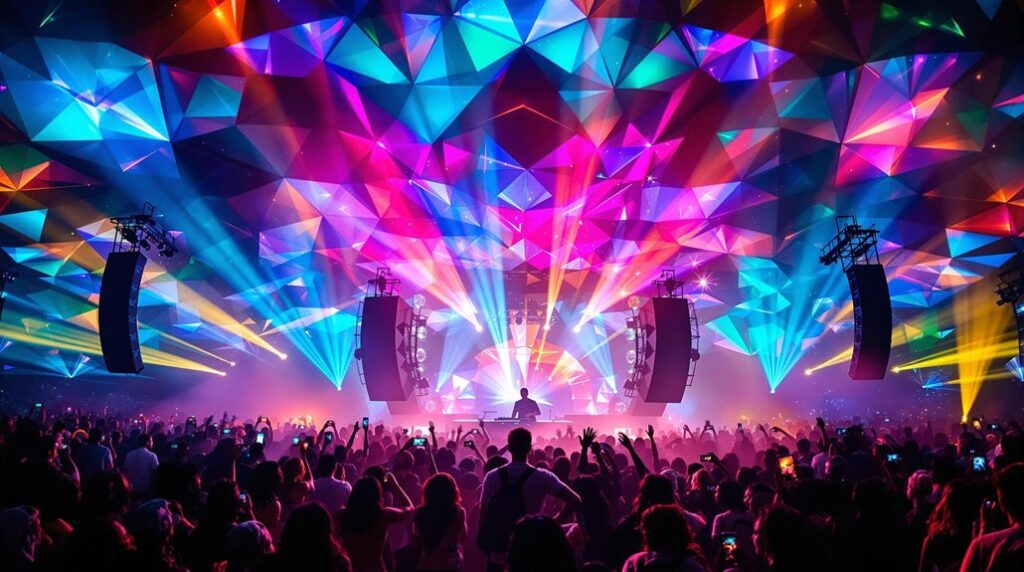You’ve observed essential milestones in electronic dance music’s evolution. Initially, house music emerged from Chicago’s underground clubs in the late 1970s, characterized by its hypnotic 4/4 beats and soulful vocals. The techno revolution followed in Detroit during the late 1980s, founded by figures like Derrick May and Juan Atkins, who introduced mesmerizing rhythms and driving basslines. By the early 2000s, dubstep emerged from South London, innovated by artists like Skream, leveraging heavy basslines and syncopated rhythms. The 2000s saw EDM’s mainstream surge in the U.S., with festivals propelling its popularity. Recently, the digital and streaming era has transformed how EDM is distributed and experienced. Exploring further, you’ll uncover deeper insights into each milestone’s impact on the music world.
Key Takeaways
- Birth of House Music in Chicago during the late 1970s, pioneering a new genre with soulful vocals and 4/4 beats.
- Techno emerged from Detroit in the late 1980s, crafted by innovators like Derrick May and Juan Atkins, emphasizing rhythmic progressions and driving basslines.
- Introduction of Dubstep in early 2000s London, characterized by its heavy basslines and distinctive wobble bass, spearheaded by artists like Skream.
- Mainstream EDM boom in the 2000s in the U.S., propelled by festivals and stars like Tiësto and Daft Punk, blending EDM with pop influences.
- Rise of digital music platforms and streaming services, revolutionizing how EDM is distributed and consumed globally.
Birth of House Music
House music, often characterized by its 4/4 beat and soulful vocals, originated in Chicago in the late 1970s as a dynamic response to the disco scene. Stemming from its Chicago roots, this genre wasn’t merely an evolution of disco but a vibrant, countercultural movement that sought to simplify and strip back the opulence associated with disco music. You’ll find the essence of house music embedded in its ability to merge repetitive, hypnotic beats with deep, resonant basslines, creating a sound that was both accessible and deeply expressive.
As an underground movement, house music initially flourished in small, dimly lit clubs away from the mainstream spotlight. It was in these hidden enclaves that DJs like Frankie Knuckles and Ron Hardy experimented with synthesizers and drum machines to craft a sound that was emphatically different from the chart-topping hits of the time. These spaces, especially The Warehouse, became sanctuaries where marginalized communities, especially from the LGBTQ+ circles, found solace and expression. House music’s growth was twofold: it was both a sonic innovation and a social revolution, encapsulating the ethos of a generation aiming for both artistic authenticity and personal liberation.
Techno Revolution
In the late 1980s, Detroit became the birthplace of techno, a genre that melded elements of house and synth-pop to forge a distinct musical landscape. As you explore deeper into this era, it’s essential to acknowledge the significant contributions of Detroit pioneers like Derrick May and Juan Atkins. These artists not only shaped the sound of techno but also crafted futuristic soundscapes that continue to influence the genre.
Consider the following aspects that define techno:
- Seamless Progressions: The backbone of techno, these create a rhythmic foundation that’s both hypnotic and energizing.
- Mesmerizing Melodies: Layered over the beats, these melodies enhance the immersive experience, inviting you to lose yourself in the music.
- Driving Basslines: Driving the momentum, these basslines make the music irresistibly danceable, pulsating through the body of every listener.
- Smooth Shifts: Crafted with precision, shifts between tracks are often imperceptible, maintaining the flow and energy of the set.
Detroit’s techno revolution wasn’t just about the music; it was an auditory journey into uncharted territories, a bold exploration of what electronic music could become. As you reflect on this transformative period, it’s clear that the techno pioneers weren’t just creating tracks; they were envisioning a new future.
Rise of Dubstep
Dubstep’s emergence in South London during the early 2000s marked a significant evolution in electronic dance music, characterized by its deep basslines and intricate rhythms. You’ve probably felt the pulsating energy of tracks with tempos usually between 135 and 145 BPM, a signature that differentiates dubstep from other electronic genres.
Key figures like Skream, Benga, and Digital Mystikz pioneered this movement, deeply embedded in the underground scene. Skream’s influence, in particular, was monumental; his tracks not only defined the sound but also guided dubstep’s trajectory from niche clubs to global stages, although still away from mainstream EDM spotlight during its formative years.
The wobble bassline became a hallmark of dubstep, transforming how electronic music could convey both complexity and raw power. Here’s a breakdown of dubstep’s core attributes in the early days:
| Feature | Description | Importance |
|---|---|---|
| Heavy Basslines | Deep, reverberating bass sounds | Central to genre identity |
| Syncopated Rhythms | Off-beat rhythmic patterns | Enhances unique sound |
| Wobble Bassline | Modulating, intense bass sound | Symbol of dubstep power |
Analyzing these elements, you can see how they collectively crafted a sonic experience that was revolutionary within the electronic music landscape.
Mainstream EDM Surge
As the 2000s unfolded, EDM’s popularity soared in the U.S., fueled by the influence of international DJs and music producers like Tiësto, Daft Punk, and David Guetta. This period marked a critical pivot as electronic dance music moved from niche club scenes to massive mainstream stages, with festival culture becoming a significant driving force behind its widespread appeal.
The collaborations trend further exemplified this surge. High-profile partnerships between DJs and pop artists made EDM more accessible and appealing to a broader audience, leading to its integration into pop and hip-hop. You’ll notice these transformations manifested vividly in several ways:
- *Madonna’s ‘Ray of Light’ album*, which brought electronic music to mainstream listeners and set a precedent for future cross-genre collaborations.
- *The emergence of dubstep in the U.S.*, with artists like Skrillex, who infused EDM with other musical styles, attracting a diverse and younger demographic.
- *The proliferation of EDM in major music festivals*, turning these events into cultural phenomena that celebrate electronic music’s diverse styles.
- *The rise of superstar DJs*, such as The Chainsmokers and Martin Garrix, whose works dominated both dance floors and radio airwaves, propelling EDM to unprecedented commercial heights.
This mainstream surge of EDM reshaped the music industry’s landscape, making electronic beats a staple in the global music scene.
Digital and Streaming Era
Following the surge in mainstream popularity, streaming platforms like Spotify and Apple Music have fundamentally altered how electronic dance music is distributed and consumed globally. These online platforms not only provide a stage for established artists but also allow emerging talents to reach international audiences without traditional barriers. The integration of digital music production software such as Ableton Live and FL Studio has further democratized the creation process, enabling a proliferation of creative talent within the EDM community.
In this digital and streaming era, you’ve witnessed a transformative shift towards virtual concerts and live streams. Pioneering artists like Marshmello and Deadmau5 have leveraged technology to host immersive online performances, setting a precedent for virtual festivals. Major EDM festivals such as Tomorrowland and Ultra Music Festival have adapted by incorporating live streaming, significantly expanding their global viewer base and influence. This shift not only reflects technological advancements but also a strategic response to changing consumer preferences in a digitally connected world.
Additionally, the ease of online collaboration has spurred a wave of innovative productions, blending diverse influences across the globe. This cross-pollination of musical ideas continues to enrich the electronic dance music landscape, underscoring the profound impact of the digital and streaming era on the genre’s evolution.
Frequently Asked Questions
How Has Electronic Dance Music (Edm) Evolved Over the Years?
EDM’s evolution mirrors its global impact and festival culture expansion, shifting from niche underground scenes to mainstream powerhouses, propelled by technological advances and genre-blending, reshaping music landscapes and listener experiences worldwide.
What Are the Three Stages in the Evolution of Electronic Music?
You’ve witnessed electronic music’s evolution through three stages: early experimental roots, the rise of genre-specific movements like house and techno, and the integration into mainstream pop, marked by instrumental innovations and genre diversification.
What Are the Main Musical Features of Electronic Dance Music?
You’ll find that electronic dance music showcases diverse production techniques and a broad instrumental variety, including synthesized sounds and digital effects that craft its pulsating beats and immersive soundscapes.
Who Were the Pioneers of Edm?
You’ll find that pioneers like Frankie Knuckles and Giorgio Moroder not only shaped genres but also influenced pop music and genre hybridization, creating a rich, detailed tapestry in the evolution of electronic dance music.
Conclusion
As you’ve journeyed through the pivotal milestones in electronic dance music’s evolution, it’s clear that each phase, from the birth of house music to the digital and streaming era, hasn’t only reflected but also shaped societal shifts and technological advancements.
Analyzing these progressions reveals a dynamic interplay between innovation and culture, underscoring EDM’s role as a progressive musical form. This exploration enriches our understanding of how electronic dance music continues to influence and redefine the global musical landscape.




